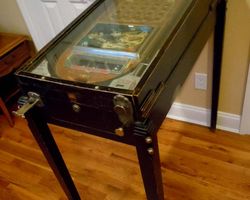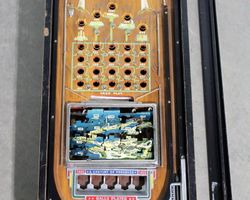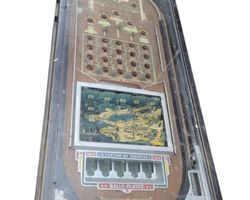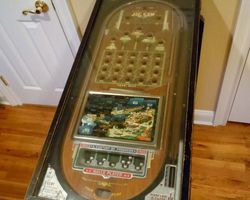World's Fair Jig-Saw
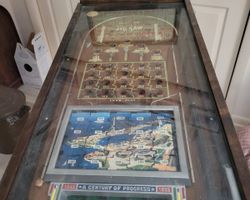
Average Prices: USD $1,000 to $3,500
Produced: August, 1933
Machine Type: Pure Mechanical
Players: 1
Design by: David Rockola
The World's Fair Jig-Saw pinball machine, produced by the Rock-ola Manufacturing Corporation in 1933, stands as a significant artifact from the formative years of pinball. Conceived by David Rockola, the machine was a direct homage to the "A Century of Progress International Exposition," more commonly known as the 1933 Chicago World's Fair. This timing was no coincidence; the exposition drew millions, offering a potent thematic backdrop for an amusement device. Released in August 1933, the World's Fair Jig-Saw saw an astonishing production run of approximately 70,000 units. This monumental figure underscores its immense popularity and market penetration during a challenging economic period, reflecting a widespread desire for affordable entertainment. The sheer volume of production also makes it one of the most widely distributed games of its era, although far fewer examples remain today, with estimates suggesting around 200 still exist. The game’s advertised dimensions—38 inches long, 19 inches wide, and 42 inches high with its legs—highlighted a "new" standard height for Rock-ola games, suggesting a deliberate evolution in cabinet design for player comfort and visibility. Pricing options varied, typically offering 1 cent or 5 cent play, with an example configuration providing 10 balls for 5 cents, catering to diverse budgets of the time. The game's name itself carried subtle variations; while its formal designation was 'Jigsaw', it was frequently marketed as 'World's Fair Jigsaw', and the playfield prominently displayed the hyphenated 'Jig-Saw', reflecting the manufacturer's flexible approach to branding.
Signature Features and Design
The World's Fair Jig-Saw distinguishes itself through its ingenious mechanical design, especially considering its purely mechanical nature. Unlike later pinball machines that would rely on electricity for lights, sound, and flippers, this Rock-ola creation operates without any electrical components or even a traditional backglass. Its most defining characteristic is the interactive jigsaw puzzle integrated directly into the playfield. As balls fall into designated holes, corresponding puzzle pieces on the playfield mechanically align themselves, progressively revealing a map of the 1933 Chicago World's Fair. This playfield animation was a remarkable feat of engineering for its time, providing dynamic feedback that captivated players. Visually, the machine presents a blend of aesthetic influences. The cabinet and legs showcase an elegant Art Deco styling, reflecting the prevalent design movement of the 1930s. This is contrasted by more Industrial-styled elements on the playfield itself, creating a distinctive and visually engaging appearance. The absence of elaborate cabinet artwork directs attention to the intricate playfield and its unique mechanical action. The manual plunger, a staple of early pinball, serves as the player's primary interface, requiring a degree of skill to launch balls effectively onto the playfield. This clever integration of a tangible, interactive puzzle element makes the World's Fair Jig-Saw a standout example of early amusement device innovation.
Playfield and Mechanics
The playfield of the World's Fair Jig-Saw is laid out as a bagatelle-style game, designed to funnel balls into specific scoring opportunities and, critically, into the holes that activate the jigsaw puzzle. The primary objective revolves around skillfully aiming the 10 balls provided to complete the five rows of the puzzle. The top of the playfield features a "Double Score" hole, which demands a true skill shot from the manual plunger to achieve, offering a significant bonus to players who master its trajectory. Once plunged, the ball circles the perimeter of the playfield before settling into an area where gravity and subtle playfield angles guide it towards various scoring holes or the crucial puzzle piece activators. Depending on where the ball lands within a specific row, it can turn over anywhere from one to five jigsaw pieces, adding an element of strategy and chance to each shot.
The artwork on the playfield, while minimalistic in color compared to later games, is thoughtfully designed to reveal the iconic layout of the 1933 World's Fair as the puzzle progresses. The interplay of Art Deco lines on the cabinet with the functional, industrial aesthetic of the playfield creates a cohesive and appealing visual experience. The lighting, entirely natural given the absence of electrical components, illuminates the detailed puzzle pieces and the pathways of the ball. The design philosophy behind this layout was to create an immersive experience around a clear, tangible goal: completing the puzzle. This direct, visual progression provides immediate feedback and a clear sense of achievement, a powerful draw for players of the era. The mechanical ingenuity that allows the puzzle pieces to self-align when a ball drops into a corresponding hole is a testament to the foresight and craftsmanship involved in its creation.
Gameplay Dynamics
Gameplay on the World's Fair Jig-Saw is centered entirely on the engaging mechanic of completing the 1933 World's Fair jigsaw puzzle. Players are given 10 balls to achieve this objective, making each plunge and subsequent drop critical. The core challenge lies in strategically landing balls in specific holes that correspond to the puzzle pieces. As a ball finds its mark, the associated mechanical puzzle pieces on the playfield visibly flip or turn, revealing a portion of the map. The game progresses as players fill in all five rows of the puzzle, a task that requires both precision and a bit of luck. The "Double Score" hole, situated at the pinnacle of the playfield, represents the machine's prime skill shot. A perfectly executed manual plunge allows the ball to arc around the playfield and settle into this high-value target, rewarding players for their mastery of the manual plunger.
While devoid of the complex modes or multiball features of modern pinball, the World's Fair Jig-Saw generates a compelling "just one more game" appeal through its unique core mechanic. The satisfaction derived from seeing the puzzle incrementally unfold, piece by piece, provides a distinct sense of accomplishment. Successfully completing the entire puzzle within the 10-ball limit offers a profound and unique gaming triumph. The game's dynamics emphasize a refined sense of touch and aim over frantic flipper action, encouraging players to think about each shot's trajectory and the potential impact it will have on the puzzle's progression. It's a game that rewards patience and a steady hand, making the completion of the World's Fair map a truly memorable and challenging objective.
Reception and Legacy
The World's Fair Jig-Saw has garnered significant admiration within the pinball community, largely due to its historical importance and the remarkable ingenuity of its purely mechanical design. Its strengths are frequently highlighted: the cleverness of its jigsaw puzzle mechanic, which provides an enduring and unique gameplay experience; its status as a direct link to the earliest days of pinball, showcasing a period before flippers, electricity, or sound were standard; and its compelling visual appeal, with its Art Deco cabinet and intricate playfield art. Collectors often cite the machine's "just one more game" quality, fueled by the rewarding sense of accomplishment upon completing the puzzle. The presence of a genuine skill shot, the "Double Score" hole, also contributes to its replayability, demonstrating that even early mechanical games demanded player dexterity. The mechanical animation of the puzzle pieces is consistently praised as an engineering marvel for its era. Furthermore, there is ongoing effort within the community to reproduce parts, offering hope for the restoration of more of the surviving units.
However, its nature as a purely mechanical device from the 1930s also presents certain characteristics that some players accustomed to modern machines might perceive differently. The absence of flippers, lighting, sound, or electronic scoring means it lacks the immediate sensory feedback and dynamic interaction of contemporary pinball. While this is inherent to its historical context, it means the game often defies conventional modern pinball rating systems. Another practical concern is the condition of many surviving machines, which frequently exhibit wear and damage from decades of use and neglect. Despite these points, the World's Fair Jig-Saw maintains a strong reputation. It is widely considered a foundational piece in pinball history, a testament to the early brilliance in game design. Its immense production numbers in 1933 reflect its widespread appeal and commercial success, influencing the burgeoning amusement industry. The machine serves as an important reminder of pinball's origins as a sophisticated mechanical device, laying groundwork for the electromechanical and solid-state innovations that would follow. For many, it is not merely a game but a tangible piece of history, demonstrating the roots of an entertainment medium that continues to evolve.
Sponsored Links
 Ebay Listings
Ebay Listings
 Auction Results
Auction Results
| Cost | Location | Date |
|---|---|---|
| USD $650 |  Maryland, United States Maryland, United States |
27 March, 2025 |
| USD $650 |  New Jersey, United States New Jersey, United States |
26 March, 2025 |
| USD $3,999 |  Pennsylvania, United States Pennsylvania, United States |
10 February, 2025 |
| USD $1,500 |  Florida, United States Florida, United States |
09 October, 2024 |
| USD $2,200 |  New York, United States New York, United States |
28 March, 2024 |
| USD $4,000 |  Nevada, United States Nevada, United States |
31 January, 2024 |
| USD $2,900 |  New York, United States New York, United States |
03 August, 2022 |
| GBP £316 |  United Kingdom United Kingdom |
01 December, 2021 |
| USD $2,900 |  New York, United States New York, United States |
18 November, 2021 |
| USD $2,900 |  New York, United States New York, United States |
09 September, 2021 |


Private Policy · Search Website · Contact Us
As an eBay Partner, we may earn a commission from qualifying purchases made through links on this site, at no additional cost to you.
All trademarks and copyrighted materials remain property of their respective owners. All other content copyright 2007 - 2025 Pinpedia.


